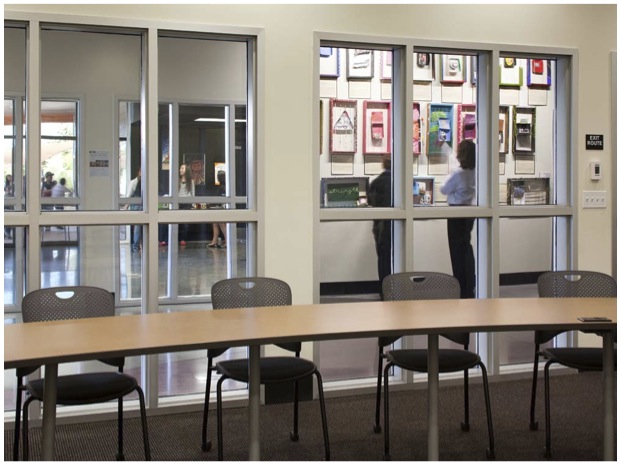How Fire Rated Glass Is Applied in Sustainable Building Design
Using Fire Rated Glazing in Sustainable Building Design. This article looks at how fire rated glazing can help earn LEED credits, and other ways that fire rated glazing leads to sustainable design and safety.
Using Fire Rated Glazing in Sustainable Design
Fire rated glass has come a long way from the days when only small panes of wired glass were used in very limited applications. Today’s clear, fire rated glass and framing products go as far as meeting the stringent wall standard (ASTM E-119), enabling wall-to-wall and floor-to-ceiling expanses of glass rated for up to 2 hours. By using fire rated glass as a building material, designers can maximize light penetration deep within a building, increase opportunities for shared artificial lighting and provide greater visual access between occupancies and stairwells.
Adding natural and shared light cuts on electricity use and helps buildings earn LEED (Leadership in Energy and Environmental Design “ US Green Building Council) points. Fire rated glass products with insulation, or low-e or energy performance, or acoustic characteristics help earn additional LEED points.
Beyond the LEED rating system, using fire rated glass in corridors, stairwells and other locations adds to sustainable building design by providing visual and acoustic comfort, security, and built-in fire protection that preserves building components and materials 24 hours a day, 7 days a week without the need for mechanical triggers.
How Fire Rated Glass can help earn LEED credits
The U.S. Green Building Council developed a LEED rating system to provide independent, third-party verification that a building, home or community was designed and built using strategies aimed at achieving high performance in key areas of human and environmental health: sustainable site development, water savings, energy efficiency, materials selection and indoor environmental quality. The LEED rating assesses a building as a whole. The choice of particular building products can contribute toward earning LEED points.
The following is a summary of LEED credits that may be gained by using fire rated glass and framing assemblies as a building material.
* Energy & Atmosphere
Using glass instead of opaque materials adds daylight, enacts passive solar design and enhances a buildings energy performance by reducing the lighting and heating loads. SAFTIFIRST SuperLite products can be insulated and provided in low-e or energy performance makeups which further improves energy efficiency.
SuperLite II-XL and GPX Framing assemblies have NFRC (National Fenestration Rating Council) certifications for U-Factor, Solar Heat Gain Coefficient and Condensation Resistance, which can help gain an additional LEED credit for optimal energy performance.
To meet property line and energy performance requirements, NFRC certified SuperLite II-XL and GPX assemblies from SAFTIFIRST were used for the windows and glass balconies on all 32 floors in the south-facing elevation of Sapphire Towers in San Diego, California.
* Materials & Resources
Fire rated glass products are supplied to a construction site in the exact quantities needed, so there is no construction waste. The products are delivered on wood pallets or in shipping boxes made from recycled materials. (Two possible LEED credits for construction waste management.)
Steel used in GPX framing systems contain 30% by weight pre-consumer recycled content and aluminum used in GPX framing systems contain 25% by weight pre-consumer recycled content. (Two possible LEED credits for recycled content materials.)
SAFTIFIRST makes all its products in Merced, California and sources the primary raw material sand from less than 70 miles of the manufacturing plant. (Two possible LEED credits for using regional materials for projects in California and parts of Nevada and Arizona.)
* Indoor Environmental Quality
Although, glass and framing omit no volatile organic compounds (VOCs), the current LEED rating system fails to give credit for glass and metal products. However, by using glass products in places not normally glazed, such as corridors and stairwells, designers can bring in daylight and provide views to the outdoors. (One credit for day light and views.)
Innovative design that that goes above and beyond existing LEED standards can bring up to an additional five (5) LEED credits. Innovative credits might be gained by inserting a floor-to-ceiling glass wall, incorporating glass that meets acoustic standards in schools or using PYRAN Platinum products that have Cradle to Cradle (C2C) certification.
Beyond LEED Fire Rated Glass promotes sustainable design
SAFTIFIRST fire rated glazing systems not only help a project achieve LEED certification, but can also contribute to overall sustainable design above and beyond LEED. Here are some of the ways:
 |
Provide safety and security, including protection against smoke, fire, radiant heat (and with certain products, protection from ballistic, hurricanes and blasts) and added visibility in corridors, stairwells and other closed-off areas where attack could occur. Stairwells, which are typically closed off from view and hard to illuminate, were given a makeover at Pomona College in Pomona, California, using SuperLite II-XL in GPX framing.
Provide daylight and visual comfort. Innovative use of fire rated glass assemblies in lieu of opaque materials allows for light penetration deep into a building while avoiding glare and direct solar lighting on work surfaces. Visual comfort can include both views to outdoor spaces and avoidance of glare.
Provide built-in fire protection. By limiting the spread of fire, smoke and the effects of radiant heat, fire rated glazing preserves building components and materials and reduces the amount of raw materials and energy required to reconstruct and renovate after a fire.
